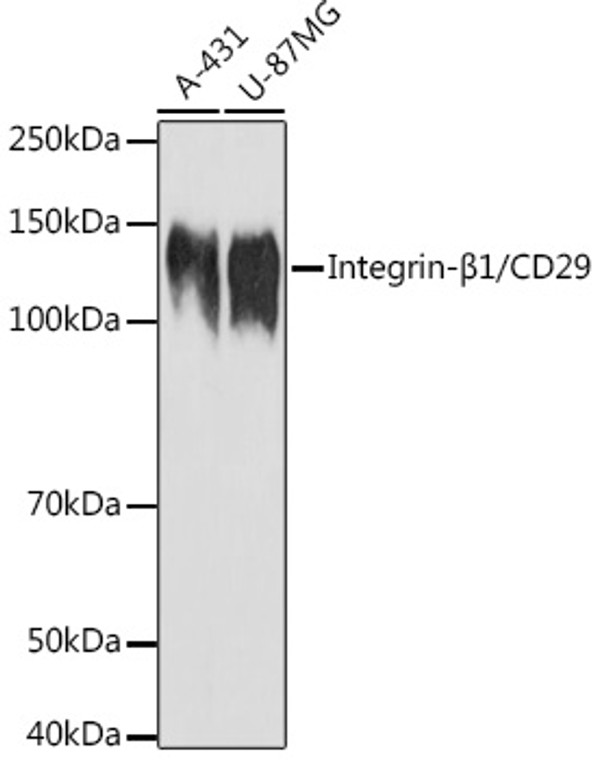| Tissue Specificity | Isoform 1: Expressed in placenta (at protein level). Widely expressed, other isoforms are generally coexpressed with a more restricted distribution. Isoform 2: Expressed in skin, liver, skeletal muscle, cardiac muscle, placenta, umbilical vein endothelial cells, neuroblastoma cells, lymphoma cells, hepatoma cells and astrocytoma cells. Isoform 3: Together with isoform 4, is expressed in muscle, kidney, liver, placenta, cervical epithelium, umbilical vein endothelial cells, fibroblast cells, embryonal kidney cells, platelets and several blood cell lines. Expressed in non-proliferating and differentiated prostate gland epithelial cells and in platelets, on the surface of erythroleukemia cells and in various hematopoietic cell lines. Isoform 4: Together with isoform 3, is expressed in muscle, kidney, liver, placenta, cervical epithelium, umbilical vein endothelial cells, fibroblast cells, embryonal kidney cells, platelets and several blood cell lines. Rather than isoform 3, is selectively expressed in peripheral T-cells. Isoform 5: Expressed specifically in striated muscle (skeletal and cardiac muscle). |
| Function | Integrins alpha-1/beta-1, alpha-2/beta-1, alpha-10/beta-1 and alpha-11/beta-1 are receptors for collagen. Integrins alpha-1/beta-1 and alpha-2/beta-2 recognize the proline-hydroxylated sequence G-F-P-G-E-R in collagen. Integrins alpha-2/beta-1, alpha-3/beta-1, alpha-4/beta-1, alpha-5/beta-1, alpha-8/beta-1, alpha-10/beta-1, alpha-11/beta-1 and alpha-V/beta-1 are receptors for fibronectin. Alpha-4/beta-1 recognizes one or more domains within the alternatively spliced CS-1 and CS-5 regions of fibronectin. Integrin alpha-5/beta-1 is a receptor for fibrinogen. Integrin alpha-1/beta-1, alpha-2/beta-1, alpha-6/beta-1 and alpha-7/beta-1 are receptors for lamimin. Integrin alpha-6/beta-1 (ITGA6:ITGB1) is present in oocytes and is involved in sperm-egg fusion. Integrin alpha-4/beta-1 is a receptor for VCAM1. It recognizes the sequence Q-I-D-S in VCAM1. Integrin alpha-9/beta-1 is a receptor for VCAM1, cytotactin and osteopontin. It recognizes the sequence A-E-I-D-G-I-E-L in cytotactin. Integrin alpha-3/beta-1 is a receptor for epiligrin, thrombospondin and CSPG4. Alpha-3/beta-1 may mediate with LGALS3 the stimulation by CSPG4 of endothelial cells migration. Integrin alpha-V/beta-1 is a receptor for vitronectin. Beta-1 integrins recognize the sequence R-G-D in a wide array of ligands. When associated with alpha-7 integrin, regulates cell adhesion and laminin matrix deposition. Involved in promoting endothelial cell motility and angiogenesis. Involved in osteoblast compaction through the fibronectin fibrillogenesis cell-mediated matrix assembly process and the formation of mineralized bone nodules. May be involved in up-regulation of the activity of kinases such as PKC via binding to KRT1. Together with KRT1 and RACK1, serves as a platform for SRC activation or inactivation. Plays a mechanistic adhesive role during telophase, required for the successful completion of cytokinesis. Integrin alpha-3/beta-1 provides a docking site for FAP (seprase) at invadopodia plasma membranes in a collagen-dependent manner and hence may participate in the adhesion, formation of invadopodia and matrix degradation processes, promoting cell invasion. ITGA4:ITGB1 binds to fractalkine (CX3CL1) and may act as its coreceptor in CX3CR1-dependent fractalkine signaling. ITGA4:ITGB1 and ITGA5:ITGB1 bind to PLA2G2A via a site (site 2) which is distinct from the classical ligand-binding site (site 1) and this induces integrin conformational changes and enhanced ligand binding to site 1. ITGA5:ITGB1 acts as a receptor for fibrillin-1 (FBN1) and mediates R-G-D-dependent cell adhesion to FBN1. ITGA5:ITGB1 acts as a receptor for fibronectin FN1 and mediates R-G-D-dependent cell adhesion to FN1. ITGA5:ITGB1 is a receptor for IL1B and binding is essential for IL1B signaling. ITGA5:ITGB3 is a receptor for soluble CD40LG and is required for CD40/CD40LG signaling. Plays an important role in myoblast differentiation and fusion during skeletal myogenesis. Isoform 2: Interferes with isoform 1 resulting in a dominant negative effect on cell adhesion and migration (in vitro). Isoform 5: Isoform 5 displaces isoform 1 in striated muscles. (Microbial infection) Integrin ITGA2:ITGB1 acts as a receptor for Human echoviruses 1 and 8. (Microbial infection) Acts as a receptor for Cytomegalovirus/HHV-5. (Microbial infection) Acts as a receptor for Epstein-Barr virus/HHV-4. (Microbial infection) Integrin ITGA5:ITGB1 acts as a receptor for Human parvovirus B19. (Microbial infection) Integrin ITGA2:ITGB1 acts as a receptor for Human rotavirus. (Microbial infection) Acts as a receptor for Mammalian reovirus. (Microbial infection) In case of HIV-1 infection, integrin ITGA5:ITGB1 binding to extracellular viral Tat protein seems to enhance angiogenesis in Kaposi's sarcoma lesions. (Microbial infection) Interacts with CotH proteins expressed by fungi of the order mucorales, the causative agent of mucormycosis, which plays an important role in epithelial cell invasion by the fungi. Integrin ITGA3:ITGB1 may act as a receptor for R.delemar CotH7 in alveolar epithelial cells, which may be an early step in pulmonary mucormycosis disease progression. (Microbial infection) May serve as a receptor for adhesin A (nadA) of N.meningitidis. |
| Protein Name | Integrin Beta-1Fibronectin Receptor Subunit BetaGlycoprotein IiaGpiiaVla-4 Subunit BetaCd Antigen Cd29 |
| Database Links | Reactome: R-HSA-1566948Reactome: R-HSA-1566977Reactome: R-HSA-198933Reactome: R-HSA-202733Reactome: R-HSA-210991Reactome: R-HSA-2129379Reactome: R-HSA-216083Reactome: R-HSA-2173789Reactome: R-HSA-3000157Reactome: R-HSA-3000170Reactome: R-HSA-3000178Reactome: R-HSA-416700Reactome: R-HSA-445144Reactome: R-HSA-446343Reactome: R-HSA-447041Reactome: R-HSA-5663220Reactome: R-HSA-6785807Reactome: R-HSA-75892Reactome: R-HSA-8874081Reactome: R-HSA-8875513Reactome: R-HSA-9013149Reactome: R-HSA-9013404Reactome: R-HSA-9013408Reactome: R-HSA-9013423Reactome: R-HSA-9609690Reactome: R-HSA-9634597Reactome: R-HSA-9679191 |
| Cellular Localisation | Cell MembraneSingle-Pass Type I Membrane ProteinCell ProjectionInvadopodium MembraneRuffle MembraneRecycling EndosomeMelanosomeCleavage FurrowLamellipodiumCell JunctionFocal AdhesionHighly Enriched In Stage I MelanosomesLocated On Plasma Membrane Of Neuroblastoma Nmb7 CellsIn A Lung Cancer Cell LineIn Prometaphase And MetaphaseLocalizes Diffusely At The Membrane And In A Few Intracellular VesiclesIn Early TelophaseDetected Mainly On The Matrix-Facing Side Of The CellsBy Mid-TelophaseConcentrated To The Ingressing Cleavage FurrowMainly To The Basal Side Of The FurrowIn Late TelophaseConcentrated To The Extending Protrusions Formed At The Opposite Ends Of The Spreading Daughter CellsIn Vesicles At The Base Of The Lamellipodia Formed By The Separating Daughter CellsColocalizes With Itgb1bp1 And Metastatic Suppressor Protein Nme2 At The Edge Or Peripheral Ruffles And Lamellipodia During The Early Stages Of Cell Spreading On Fibronectin Or CollagenTranslocates From Peripheral Focal Adhesions Sites To Fibrillar Adhesions In A Itgb1bp1-Dependent MannerEnriched Preferentially At InvadopodiaCell Membrane Protrusions That Correspond To Sites Of Cell InvasionIn A Collagen-Dependent MannerLocalized At Plasma And Ruffle Membranes In A Collagen-Independent MannerIsoform 2: Does Not Localize To Focal AdhesionsIsoform 5: Cell MembraneSarcolemmaIn Cardiac MuscleIsoform 5 Is Found In Costameres And Intercalated Disks |
| Alternative Antibody Names | Anti-Integrin Beta-1 antibodyAnti-Fibronectin Receptor Subunit Beta antibodyAnti-Glycoprotein Iia antibodyAnti-Gpiia antibodyAnti-Vla-4 Subunit Beta antibodyAnti-Cd Antigen Cd29 antibodyAnti-ITGB1 antibodyAnti-FNRB antibodyAnti-MDF2 antibodyAnti-MSK12 antibody |







